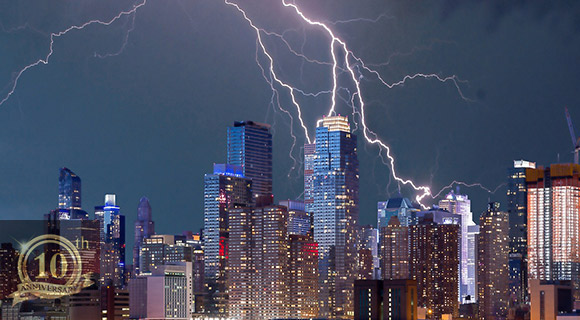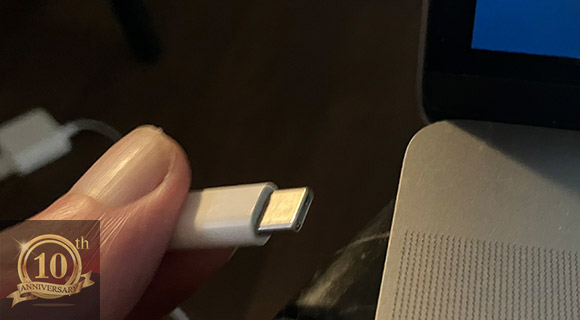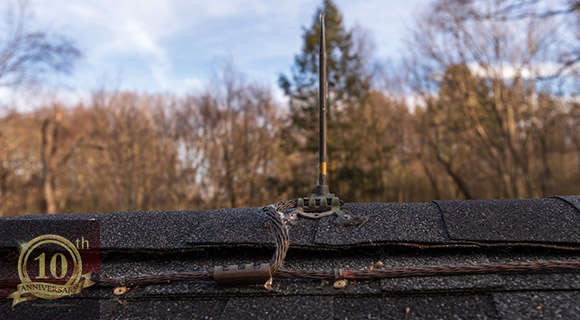Prevent a lightning strike from costing you thousands in electronics repair and replacement. Understanding lightning’s properties and how to keep your devices safe will keep you from paying for costly repairs and replacements.

New Life Technology Group gathered information about what attracts lightning, damage to electronics, how to protect your devices, and how to prevent or divert lightning strikes.
What Attracts Lightning?

Lightning forms when a buildup of electrical charges in a cloud seeks balance. A strike occurs as negative charges from the cloud find the fastest route to the ground. Since lightning looks for the quickest path, it is attracted to specific conditions:
Tall Structures – Taller buildings, trees, and poles are prime targets. If a structure towers over its surroundings, lightning is more likely to strike it. Homes and businesses with tall roofs or antennas, like those situated on elevated terrain, are more susceptible.
Metal – Conductive materials like metal attract lightning. Metal roofing, antennas, or HVAC units on buildings increase the chances of lightning hitting and causing significant damage to electrical systems.
Moisture – Water is a great electrical conductor. Wet areas around buildings—whether on roofs, trees, or even in the atmosphere—make nearby structures more likely to be struck.
Rooftop Equipment – Satellite dishes, weather vanes, and other equipment mounted on rooftops act as lightning attractors, especially when they are made of metal and stand taller than other objects on the roof.
Energy in a Lightning Strike

The power behind a lightning strike is staggering. A single bolt can carry 1 billion electrical volts and generate a 30,000 to 300,000 ampere current. This energy can cause severe damage in less than a second. The temperature inside a lightning bolt can reach 50,000°F – hotter than the sun’s surface. This immense heat and energy can melt wiring, destroy electronic components, and cause fires in homes and businesses.
Potential Damage to Electronics
When lightning strikes a building, it creates an electrical surge, passing through wiring and affecting everything connected to the electrical system. This surge can cause severe damage to:
Computers and Servers – Sensitive electronic components inside computers and servers are highly vulnerable to electrical surges. Even a brief surge can fry circuit boards, corrupt data, or destroy hard drives.
Home Appliances – Appliances like refrigerators, ovens, and washing machines are susceptible to damage from power surges. While these devices are not as sensitive as electronics like computers, they can still experience internal damage that requires costly repairs or replacements.
Television and Audio Equipment – Lightning surges through electrical wiring and antennas, destroying TVs, sound systems, and other audio/visual equipment.
HVAC Systems – Lightning can also affect larger systems, such as heating, ventilation, and air conditioning units, often leading to costly repairs or replacements after a storm.
How to Protect Your Electronics and Appliances

Given the significant risk lightning poses to electronics, protective measures are crucial. Here are some effective methods to safeguard your devices:
Surge Protectors – A surge protector is your first line of defense against power surges caused by lightning. These devices limit the voltage that reaches your electronics by diverting excess voltage to the ground. High-quality surge protectors with a built-in suppression system are highly recommended for protecting computers, televisions, and appliances.
- Whole-House Surge Protectors – Consider installing a whole-house surge protector for more comprehensive protection. This device is installed at the main electrical panel and helps prevent surges from reaching individual outlets.
Unplug Devices – The safest way to protect electronics during a lightning storm is by unplugging them. If a storm is forecasted, disconnect computers, appliances, and entertainment systems from their power sources. This prevents a voltage surge from damaging the equipment.
Use Uninterruptible Power Supplies (UPS) – A UPS device offers more protection than a typical surge protector by providing backup power to electronics during a surge or outage. A UPS keeps computers, servers, and other sensitive devices running, allowing you to safely shut them down.
Install Grounding Systems – Grounding helps ensure that electrical surges from lightning are directed safely into the earth rather than through your devices. Proper grounding is a crucial part of building design and should be implemented by licensed electricians.
Preventing or Diverting Lightning Strikes

While lightning cannot be absolutely prevented, several systems and strategies help divert lightning away from homes and businesses, reducing the risk of damage.
Lightning Protection Systems (LPS) – An LPS consists of rods, conductors, and ground electrodes (designed to channel the energy from a lightning strike into the ground). Here’s how the system works:
- Lightning Rods – Installed at the highest points on buildings, lightning rods act as receptors, attracting lightning strikes.
- Conductors – Copper or aluminum cables connect the lightning rod to ground electrodes. These cables guide the lightning’s energy from the roof to the ground.
- Grounding Electrodes – These rods are buried in the earth to safely dissipate the electrical charge from a lightning strike. Proper grounding is essential for the safe function of an LPS.
By diverting lightning from the building’s electrical system, an LPS prevents dangerous surges that could otherwise damage electronics and appliances.
Install Non-Metallic Roofing Materials – Metal roofs are durable. However, they attract lightning strikes. If you live in an area prone to lightning, consider installing less conductive roofing material, like asphalt shingles, clay tiles, or slate.
Avoid Installing Tall Structures on Rooftops – Limit the installation of tall objects like antennas or weather stations on rooftops (these attract lightning). Where possible, make use of shorter or non-metallic alternatives.
Trim Nearby Trees – Tall trees near homes or businesses can attract lightning. If struck, falling limbs or entire trees can damage roofs or electrical systems. Regular tree trimming minimizes this risk.
Who to Call After a Lightning Strike
If lightning strikes your home or business, take immediate action to prevent further damage:
Electrician – Contact a licensed electrician to inspect the building’s electrical system. Lightning surges can damage wiring, outlets, and circuit breakers, posing fire risks if not addressed.
Roofer – Have a roofing professional assess the roof for damage, particularly if lightning hits metal components or antennas.
HVAC Technician – If your HVAC system experienced electrical surges, have it inspected for internal damage to avoid future breakdowns.
Insurance Provider – Report the lightning strike to your insurance company to start a claim for any damage. Document the damage with photographs and written descriptions to support your claim.
Computer and Electronics Recycler – Donate affected electronics to a local nonprofit computer and electronics recycling center like New Life Technology Group.
Lightning and Your Electronics
In this article, you discovered what attracts lightning, its properties, how it damages electronics, and how to prevent or divert damaging lightning strikes.
Installing surge protectors, unplugging devices during storms, and investing in lightning protection systems help reduce risks and save you thousands in repairs and replacements.
Ignoring the need to protect your home or business from lightning strikes can leave you with costly expenses when you lose your data and are left with inoperable devices.
Sources:
noaa.gov/jetstream/lightning/lightning-safetyweather.gov/safety/lightningready.gov/thunderstorms-lightning

